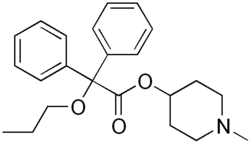Propiverina
Aspetto
| Propiverina | |
|---|---|
 | |
| Caratteristiche generali | |
| Formula bruta o molecolare | C23H29NO3 |
| Massa molecolare (u) | 367.481 g/mol |
| Numero CAS | |
| Codice ATC | G04 |
| PubChem | 4942 |
| DrugBank | DBDB12278 |
| SMILES | CCCOC(C1=CC=CC=C1)(C2=CC=CC=C2)C(=O)OC3CCN(CC3)C |
| Indicazioni di sicurezza | |
La propiverina è un farmaco ad attività anticolinergica utilizzato nel trattamento dell'incontinenza urinaria[1] e della sindrome della vescica iperattiva[2].
Agisce come antagonista del recettore muscarinico e inibisce il passaggio intracellulare di calcio[2].
Si tratta di un farmaco in genere ben tollerato, che può essere utilizzato anche nei bambini e negli adolescenti[3]. L'effetto indesiderato più comune è la xerostomia[2].
Note
[modifica | modifica wikitesto]- ^ T. Kitta, V. Tyagi; M. Nanri; M. Kiniwa; K. Nonomura; N. Yoshimura, Effects of propiverine hydrochloride, an anticholinergic agent, on urethral continence mechanisms and plasma catecholamine concentration in rats., in Int Urogynecol J, vol. 24, n. 4, aprile 2013, pp. 683-8, DOI:10.1007/s00192-012-1924-7, PMID 22930215.
- ^ a b c K. McKeage, Propiverine: a review of its use in the treatment of adults and children with overactive bladder associated with idiopathic or neurogenic detrusor overactivity, and in men with lower urinary tract symptoms., in Clin Drug Investig, vol. 33, n. 1, gennaio 2013, pp. 71-91, DOI:10.1007/s40261-012-0046-9, PMID 23288694.
- ^ WJ. Kim, DG. Lee; SW. Lee; YK. Lee; JS. Lee; KH. Park; M. Baek, Efficacy and safety of propiverine in children with overactive bladder., in Korean J Urol, vol. 53, n. 4, aprile 2012, pp. 275-9, DOI:10.4111/kju.2012.53.4.275, PMID 22536472.